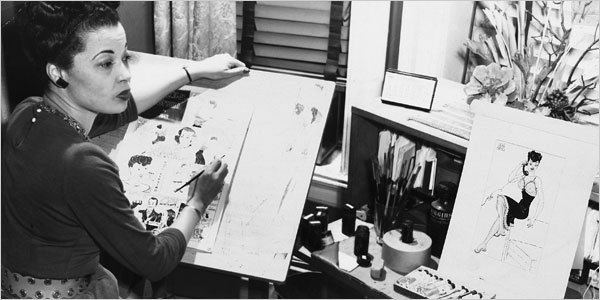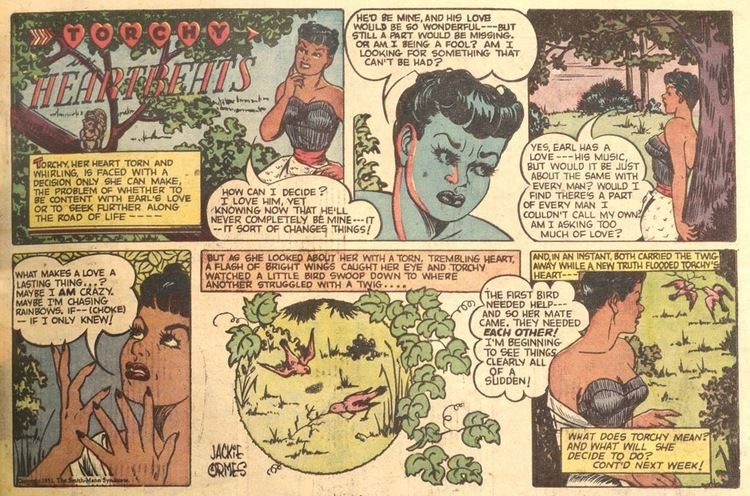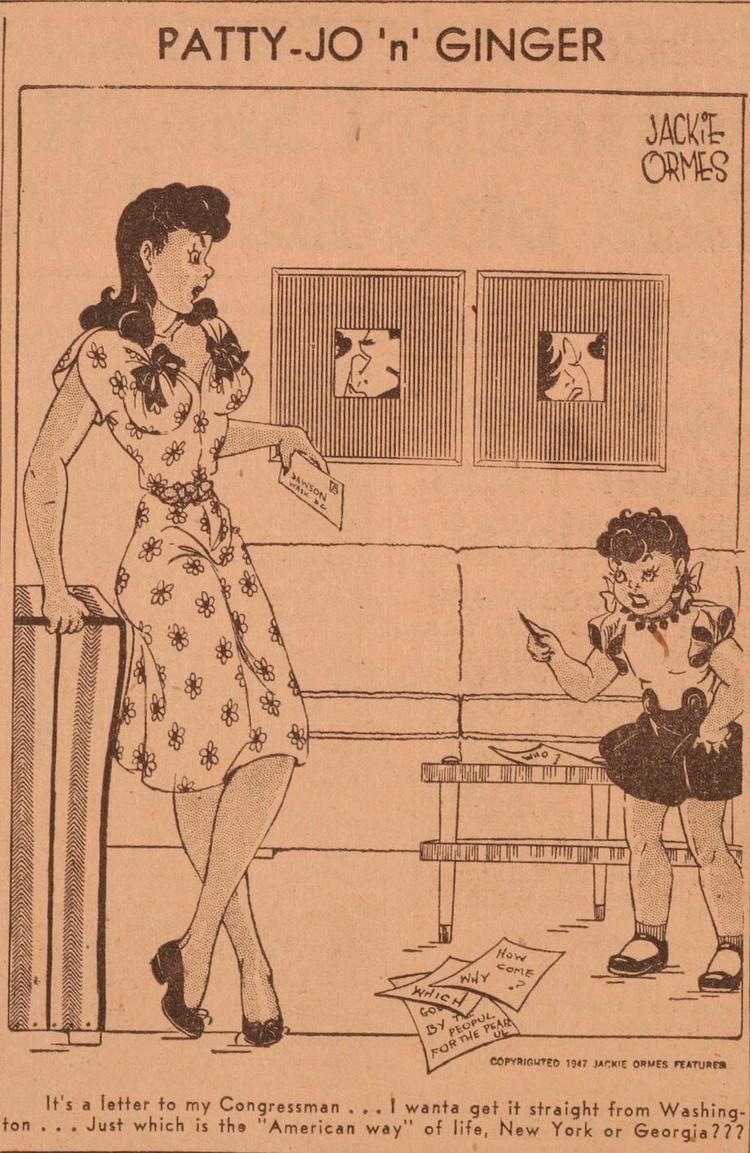Nationality American | Name Jackie Ormes Role Cartoonist | |
 | ||
Notable works Torchy Brown in Dixie to HarlemCandyPatty Jo 'n' GingerTorchy in Heartbeats (originally titled Torchy Brown Heartbeats) and accompanying Torchy Togs (paper doll cutouts). Similar E Simms Campbell , Morrie Turner , Ollie Harrington | ||
1953 jackie ormes profile
Jackie Ormes (August 1, 1911 – December 26, 1985) is known as the first African American woman cartoonist and created the Torchy Brown comic strip and the Patty-Jo 'n' Ginger panel.
Contents
- 1953 jackie ormes profile
- Jackie ormes the first african american woman cartoonist
- Early life and career
- Cartooning
- Patti Jo Dolls
- Retirement
- References

Jackie ormes the first african american woman cartoonist
Early life and career

Jackie Ormes was born Zelda Mavin Jackson on August 1, 1911 in Pittsburgh, Pennsylvania to parents William Winfield Jackson and Mary Brown Jackson. Her father William, the owner of a printing company and movie theater proprietor, was killed in an automobile accident in 1917. This resulted in the then six-year old Jackie and her younger sister Dolores in the care of their aunt and uncle for a brief period of time. Eventually, Jackie's mother remarried and the family relocated to the nearby suburb of Monongahela. Ormes described the suburb in a 1985 interview for the Chicago Reader as "spread out and simple. Nothing momentous ever happens here". She graduated from high school in Monongahela in 1930.

Ormes drew and wrote throughout high school. It was during this period that she wrote a letter to the editor of the Pittsburgh Courier, a weekly African-American newspaper that was published on Saturdays. The then-editor, Robert Van, wrote back. This correspondence led to her first writing assignment- covering a boxing match. Her coverage of future matches led her becoming an avid fan of the sport.

Ormes started in journalism as a proofreader for the Pittsburgh Courier. She also worked as an editor and as a freelance writer, writing on police beats, court cases and human interests topics. While she enjoyed "a great career running around town, looking into everything the law would allow, and writing about it", what we really wanted to do was draw.
Cartooning

Ormes's first comic strip, Torchy Brown in Dixie to Harlem, first appeared in the Pittsburgh Courier in 1937. In addition to the Courier, Torchy Brown was syndicated to fourteen other black newspapers. The strip,starring Torchy Brown, was a humorous depiction of a Mississippi teen who found fame and fortune singing and dancing in the Cotton Club. Torchy's journey from Mississippi to New York City mirrored the journey of many African-Americans who ventured northward during the Great Migration. It was through Torchy Brown that Ormes became the first African-American woman to produce a syndicated comic strip. The strip would run until 1940. The reason for the strip's abrupt end is uncertain, but it is presumed to be due to an end in her contract.

Ormes moved to Chicago in 1942, and soon began writing occasional articles and, briefly, a social column for The Chicago Defender, one of the nation's leading black newspapers, a weekly at that time. For a few months at the end of the war, her single panel cartoon, Candy, about an attractive and wisecracking housemaid, appeared in the Defender.
By August 1945, Ormes's work was back in the Courier, with the advent of Patty-Jo 'n' Ginger, a single-panel cartoon which ran for 11 years. It featured a big sister-little sister set-up, with the precocious, insightful and socially/politically-aware child as the only speaker and the beautiful adult woman as a sometime pin-up figure and fashion mannequin.
In 1950, the Courier began an eight-page color comics insert, where Ormes re-invented her Torchy character in a new comic strip, Torchy in Heartbeats. This Torchy was a beautiful, independent woman who finds adventure while seeking true love. Ormes expressed her talent for fashion design as well as her vision of a beautiful black female body in the accompanying Torchy Togs paper doll cut outs. The strip is probably best known for its last episode in 1954, when Torchy and her doctor boyfriend confront racism and environmental pollution.Ormes used Torchy in Heartbeats as a sounding board for several big issues of the time. In a 1985 interview for Chicago Reader she claimed she was " anti-war-I was anti-everything-that's-smelly". Torchy presented an image of a black woman who, in contrast to the contemporary stereotypical media portrayals, was confident, intelligent, and brave.
Patti-Jo Dolls
Ormes contracted with the Terri Lee doll company in 1947 to produce a play doll based on her little girl cartoon character. The Patty-Jo doll was on the shelves in time for Christmas and was the first American black doll to have an extensive upscale wardrobe. As in the cartoon, the doll represented a real child, in contrast to the majority of dolls that were mammy and Topsy-type dolls. The dolls were popular with both black and white children. In December 1949, Ormes's contract with the Terri Lee company was not renewed, and production ended. Patty-Jo dolls are now highly sought collectors' items.
Retirement
Jackie Ormes married accountant Earl Holmes in 1936. The couple initially moved to Salem, Ohio so Earl could be close to his family. But Ormes was not happy there, and they eventually moved back to Chicago. The pair had one child, Jaqueline, who died of a brain aneurysm at age 3. Ormes would remain married to Earl until his death in 1976.
She retired from cartooning in 1956, although she continued to create art, including murals, still lifes and portraits until rheumatoid arthritis made this impossible. She contributed to her South Side Chicago community by volunteering to produce fundraiser fashion shows and entertainments. She was also on the founding board of directors for the DuSable Museum of African American History. Ormes was a passionate doll collector, with 150 antique and modern dolls in her collection, and she was active in Guys and Gals Funtastique Doll Club, a United Federation of Doll Clubs chapter in Chicago. She died of a cerebral hemorrhage in Chicago on December 26, 1985. Ormes was posthumously inducted into the National Association of Black Journalists Hall of Fame in 2014.
